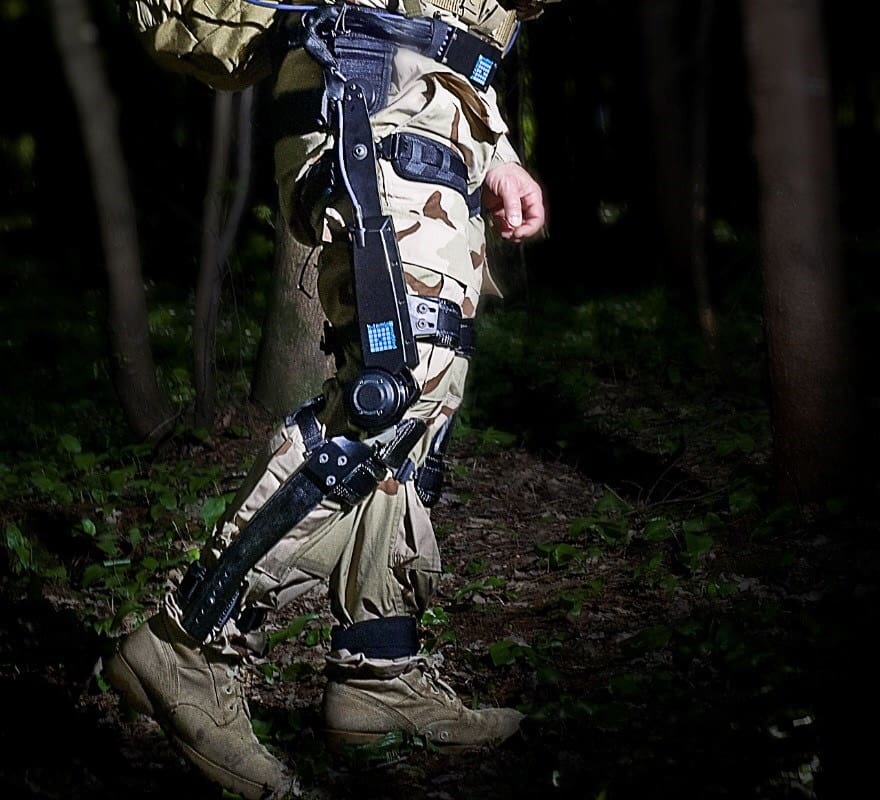TAMPA, Fla., May 16, 2017 – Their demanding missions often require soldiers to carry heavy equipment packs long distances over rough terrain, or up and down stairs and underground infrastructure in mega-cities. Exhaustion and injury are frequently a consequence of these challenging operational scenarios. A new exoskeleton from Lockheed Martin (NYSE: LMT) offers a solution.
Using licensed DermoskeletonTM bionic augmentation technology, the FORTIS Knee Stress Release Device (K-SRD)TM is a computer-controlled exoskeleton that counteracts overstress on the lower back and legs and increases mobility and load-carrying capability. It boosts leg capacity for physically demanding tasks that require repetitive or continuous kneeling or squatting, or lifting, dragging, carrying or climbing with heavy loads.
“FORTIS K-SRD features military-specification batteries that are approved for infantry use, improved control box ergonomics and faster actuators that generate more torque,” said Keith Maxwell, FORTIS program manager at Lockheed Martin Missiles and Fire Control. “These system upgrades resulted from soldier feedback on the initial design.”
Sensors on the exoskeleton report the soldier’s speed, direction and angle of movement to an on-board computer that drives electro-mechanical actuators at the knees. The exoskeleton delivers the right torque at the right time to assist knee flex and extension. FORTIS K-SRD ultimately reduces the energy needed to cross terrain, squat or kneel. These benefits are most noticeable when ascending or descending stairs or navigating inclined surfaces.
Versions of the exoskeleton are also available for industrial workers and first responders who have to perform strenuous tasks in difficult environments.
“For any mission that combines heavy man-portable gear and climbing, FORTIS K-SRD can enhance strength and endurance,” Maxwell added.
For additional information on Lockheed Martin’s exoskeleton technology, visit our website.
Tags: Lockheed Martin



All this gear and the enemy insurgent is wearing flipflops and mandresses. 16 years into the recent conflicts and we’re still getting our frontline guys weighed down with heavy comms and gear.
Sure it’s fancy and high tech but spending trillions hasn’t got us anywhere.
When it breaks down, does that mean Joe has to now carry the busted robot legs _and_ all of his gear back to the patrol base?
Or when you run out of batteries 😉
Better sign that thing down lol
Maybe someone will come up with a folding tactical wheelbarrow.
Still no support for the ankles, arch and instep. there are more stress points in the legs than knees and hips.
I would rather spend the development funds on better Log support, ultra lightweight ammunition, weapons, 3CI, Load baring equipment, field living equipment and power supplies.
My grandfather fought his way across Paua against a near parity enemy in shorts, shirt, boots, canteen and two bandoleers of .303. He had a good Log system backing him up and did not need to carry 80 Lb of kit to fight.
I’m looking at that and also thinking “Helps Soldiers Carry Heavy Gear” – on their ankles and feet instead of their knees and hips. if the system does not bear the load on the ground, a different body area will tire.
Check this out:
https://www.google.nl/search?q=EXOBUDDY&client=firefox-b-ab&source=lnms&tbm=isch&sa=X&ved=0ahUKEwjX3cL7yPnTAhURJFAKHQInDw0Q_AUICygC&biw=1268&bih=821
I saw it as well, and concur.
Any type of exoskeleton should have a exoskeleton boot to help with the load otherwise the load will be transferred to what is probably the most critical part of the servicemember. The feet.
All the additional weight carrying capacity is pointless if the SM ends up with foot injuries or fractures because of it.
Stu,
You’re right and it’s being addressed.
https://pdfs.semanticscholar.org/241f/da1489821b03498435ee38e97d1ebe4ae210.pdf
Thanks for sharing!
An anthropomorphic exoskelton requires complex control systems. Any hinderance of the natural gait will result in an increase in energy consumption and possible injury.
I doesn’t ‘get in the way’ however.
Having worked with a major defense contractor on a competing design, I can say confidently that this will be a huge game changer once these designs reach maturity. That time is coming very soon. It’s not only military capabilities, but also those of private industries that will radically change. It was the PC, cell phones, and the internet. Next are exoskeletons and nano technology.
I agree, this will be a game changer–infantry chicks will be able to keep up with their male peers.
Oh snap.
I imagine all these comments aren’t too far from when muskets came into play and archers lost their minds, when horses were replaced by jeeps, etc..
Militaries change. We can’t be the fighters of the past, the past fighters can’t be us, and many of us won’t be whatever the future fighter is.
That being said, change is hard, scary, and definitely costs lives. Over time (with enough warfighter input and experience) our systems improve and become the norm. Soon young joes will amusingly ask how the hell we did anything without robot legs and 4K HUDs in their eyepro haha
Well said. Constructive criticism is always welcome but resistance to evolution based solely on how things were done 2,3 or 4 generations before us is something I’ve never been able to understand…
A better solution to the problem of giving a soldier maximum equipment on hand is delivery drones not Robo legs. The snow goose drone is on the right track and once Amazon starts to drop off your doo-dads by drone the army will double down on the idea too.
As a paraplegic. I am wondering if this would work for an “exoskeleton”.
I have a few mates with mobility problems and missing limbs and they are pushing for their support organisations to get involved with exoskeleton projects.
They just can’t decide which one to throw money at.
Rubb points and chaffing, no thanks
How much time will soldiers have to spend for training and maintenance with this? There’s only so much time. We have to make sure soldiers don’t spend too much of their time on side projects. Anything we give them has to be obvious on how to use it, require very little maintenance, work every time, and not create lots of additional logistics traffic.